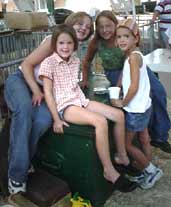|
Logan
Countyís traditionally large hog show offers increasingly
high-quality competition. It reflects the hard work of youngsters
and their families in preparing an animal for the fair. Those who
succeed here usually perform very well at the Illinois State Fair
the following week.
Click
here for Logan County results
of the Junior and Open Barrow Shows
from the Illinois State Fair.
Logan
County youth did well in the Junior Gilt Show on Sunday. Results
will be available tomorrow.
Vernon
Klockenga of Lincoln is the recently retired swine superintendent at
the Logan County Fair. In his 40 years of show management, he has
observed a number of hog showing trends. Klockenga believes one
aspect has remained constant. Show competition brings families
together.

[Danielle Peifer of
Lincoln has been showing Hampshires at the Illinois State Fair since
she was 10. The LCHS senior showed the Reserve Grand Champion Barrow
at the Logan County Fair this year. She took home fourth place in
her Hampshire barrow class at the state fair.]
Just
outside the show ring, anxious dads give last-minute advice to their
sons and daughters on how to handle the barrow or gilt in the show
ring. Moms sit in the stands armed with cameras to capture the
memorable moment of winning the class. And when there is victory,
the whole fairground community celebrates.
In
todayís world of hectic schedules, Klockenga observes that
"the most bonding for some of these families is getting hogs
ready for the fair."

[New Hollandís
Katie Conklen and her barrow wait for the judge to finish placing
the class.]
The
Klockenga family is deeply rooted in the fair tradition. "I donít
think Iíve missed a day of the fair in my life," admits
Vernon, "and I probably wonít until I die."
Even
though he is retiring as swine superintendent, Vernonís
grandchildren, Rachel and Corey Jones, are now involved in showing
hogs.
Swine
competitions are not only family traditions, but they have become
big business. Klockenga estimates that more than half of the
exhibitors purchase their pigs from purebred breeders. Although
prices for very promising gilts and barrows can spike around $800,
most youth pay around $200 for their show animal.
Those
youth who have their own sows often pay $70 for a double dose of
some of the best boar semen in the country. This process is called
artificial insemination and is largely responsible for the higher
quality of stock at many fairs.

According
to the Logan County Fair book, exhibitors must own their gilts
(females who have not yet littered) or barrows (male pigs that have
been neutered) by June 1 of that year to compete in the August fair.
(To
top of second column)
|

It
doesnít take long for newborn piglets to grow into the full-size
pork bellies on display at the fair. There is approximately one
pound of gain for every three pounds of feed consumed. So, a
crossbred gilt farrowed on Jan. 10 could easily be 270 pounds by
show time.
Logan
County Fair rules strictly align with those set forth by the state
fair. There are four gilt age brackets: Jan. 1 Ė Jan. 20, Jan. 21
Ė Feb. 10, Feb. 11 Ė Feb. 28, and all those gilts born after
March 1. The entire group of crossbred barrows is split evenly into
six weight classes, while purebred barrows fall into light, medium
and heavyweight divisions.
Klockenga
points out that barrows weighing in excess of 271 pounds are
disqualified from showing at the state fair. However, the Logan
County Fair lets them be exhibited in the super heavyweight division
without the opportunity to compete for grand champion. This is Logan
Countyís way of following state fair guidelines and still allowing
youth the positive experience of showing their projects.

There
is a fine art to limiting weight gain. About three weeks prior to
the fair, youngsters start hand feeding the hogs to
"shrink" them into the preferred weight class. They also
start walking the animals one to two miles daily to promote muscle
growth. This daily routine also helps the youngster better handle
their barrow or gilt in the show ring.
The
newest fad is to shave the pig and apply oil right before the
competition. Klockenga doesnít approve of this practice but admits
that those who donít do it often lose out on the top placings.

[Fair competitions
are a great time for
family and friends to bond.]
All
youth have the opportunity to sell their animals at the fair
auction. The top place winners usually garner $2-$3 per pound over
the market price. Others can earn an additional 50 cents. This makes
for some good profit. Those who are going on to the state fair can
either deliver their animal to the local buyers after the state fair
or pay them market price in exchange for the premium bid.
Klockenga
says that local merchants are great about purchasing animals in the
auction and providing special monetary awards and trophies to the
winners. "I donít even have to ask for their help. Itís
good public relations for them."

It
just goes to show that youth livestock competitions are a family and
community affair.
[Marty
Ahrends]
|

